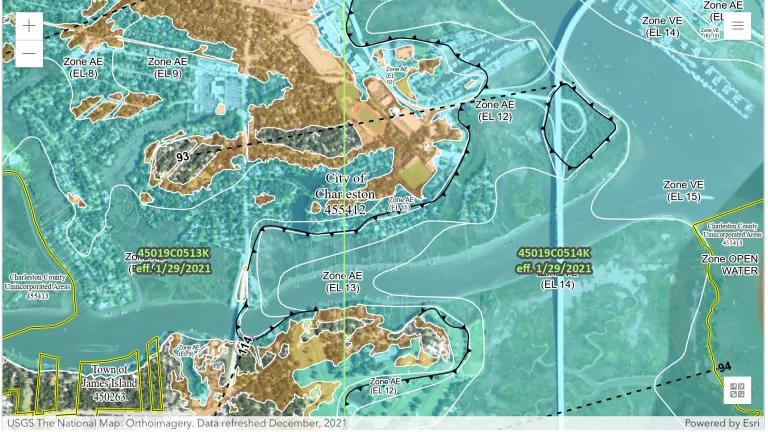"Wider, faster, treeless roads not only ruin our public places, they kill people. Taking highway standards and applying them to urban and suburban streets, and even county roads, costs us thousands of lives every year. There is no earthly reason why an engineer would ever design a 14-foot lane for a city block, yet we do it continually. Why? The answer is utterly shameful: Because that is the standard." -- Charles Marohne
As a member of NRDC's transportation team I spend a lot of my time learning about and talking up transit (buses and trains) as an alternative to pavement pollution (my just invented term) -- that is, endless ribbons of crumbling, traffic-clogged roadways which fuel our nation's oil addiction, foul the air with tailpipe emissions, mar the landscape, and lessen our quality of life.
Sure, a lot of Americans love their cars but everyone hates gridlock. As our recent public opinion poll found, few people still believe that building new roads will solve their traffic woes. By contrast, most favor investing more federal and state funds to expand and improve public transportation. Without a doubt, a more modern and efficient 21st century transportation system that favors transit delivers economic benefits and also helps families overcome the costs of car dependence. That is crucial considering that housing and transportation costs over the past decade have soared, with many families today now spending nearly 60 percent of their incomes on those two costs alone.
But aside from boosting transit to save us time and money, there are ways to modify already existing roadways to revitalize communities. My colleague Kaid Benfield knows much more about this subject than I ever will. He's NRDC's director of sustainable communities -- a big thinker on this topic and a prolific blogger. But I found the video below incredibly enlightening and inspiring. It's about building better communities through better, smarter transportation. The video clocks in at just under 20 minutes. I think it's well worth watching but if you don't have the time I'll highlight a few key points below.
First, the presenter is Ian Lockwood, the former planning director in West Palm Beach, Florida. His slide show takes the viewer through the transition of that community from an asphalt jungle plagued by street crime, a deteriorating downtown and traffic congestion to today's vibrant, walkable community with a thriving economic base centered around a redeveloped urban core marked by safe, scenic streets and a mix of retail and residential businesses.
Lockwood's guiding philosophy in remaking the city was simple. He remembered how, as a child, he could ride his bike safely from his house on the outskirts of Ottowa, Canada all the way downtwon. Growing up, he thought every city was like that.
In the mid-1990s he took the job in Florida. His first realization was that West Palm Beach featured widened streets designed simply to move cars quickly. Rather than solve traffic woes, the problem worsened -- and traveling any other way but by car was a dangerous prospect. Even worse, the wide streets essentially served to funnel people out of the city, where they settled in suburbs. Those residents driving back and forth every day for work spurred longer commutes and more congestion.
"Our downtown suffered as a result," says Lockwood. "People left. Investment left. And people became car dependent. So we started tearing down abandoned buildings to build parking lots...creating more disinvestment. The city declined over time as people moved out...to the Everglades. What we got in exchange was traffic."
The city bottomed out with 80% vacancy in its main shopping corridor and crack dealers and prostitutes took over the empty streets. All because of what Lockwood refers to as "the legacy of moving cars quickly."
The bulk of the presentation is the feel-good story of how he and his staff created and enacted a new vision for the community, adding value by reducing the size of streets, connecting neighborhoods, enhancing scenic landscaping, remaking parks, building bike paths and creating other pedestrian-friendly attributes. All this contributed to attracting people to shop, eat and live in and around the city core. Business investment followed, with new buildings and renovations of other structures that were vacant.
Lockwood boiled his approach down to a set of key principles:
- Widening roads to speed up traffic backfires by funneling residents out of the city, followed by the loss of retail and other businesses, and people end up driving more which worsens traffic
- Narrowing and slowing speeds on streets actually eases congestion while making "Main Street" more vibrant and attracting residents who also drive less while walking or riding bikes and transit more
This may seem counterintuitive, but the new and improved West Palm Beach is proof that highways through cities take away value from those communities. Value comes back to cities when the capacity of streets is not measured by how many cars can travel on it, but by how they nurture businesses and transit networks. Vibrancy therefore is not measured by the number of car trips -- vehicle miles traveled (VMT)-- but by how streets and neighborhoods are designed to enable and encourage shorter trips, preferably by transit, along with more walking, biking and socializing.
The video closes with a slide summarizing Lockwood's lessons learned:
End: Lots of little trips and less traffic (VMT)
Means: Reward short trips and/or transit
- Connected street network
- Mixed land uses
- Density
- Comfortable accomodation of walkers, cyclists, transit users
Bottom line: getting people out of their cars is good for business.
Lockwood labels this "livability." I can live with more of that!



